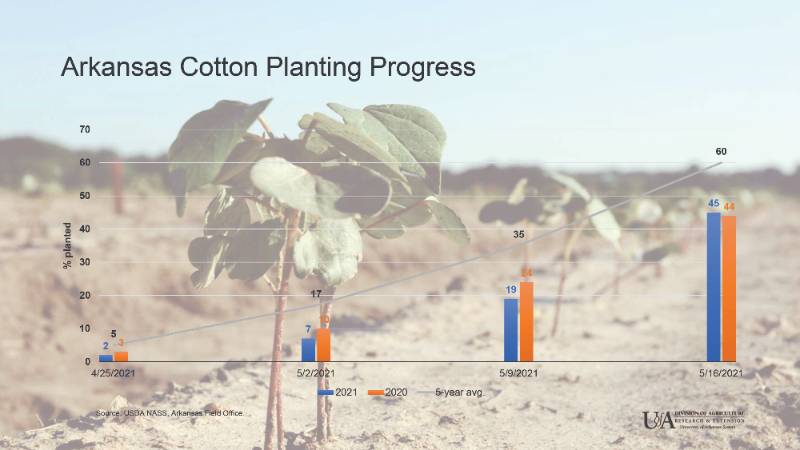Farmers plagued by spring rains ponder short-season cotton tactics
May 18, 2021
By Mary Hightower
U of A System Division of Agriculture
Fast facts
- Arkansas cotton growers facing repeat of 2020
- Planting makes good progress, but more remains
(565 words)
(Newsrooms — With image https://flic.kr/p/2kZoLzE and sidebars
With Ark-Rain-Row-Crops, 05-18-2021-Ark-Rain-Livestock, 05-18-2021-Ark-Rain-Forage-Care)
JONESBORO, Ark. — Too many wet days have compressed the planting window for cotton growers into a series of short and irregular days in the field, with farmers looking at ways to manage short-season cotton.”

The good news is “we have a track record of making later-than-we-like-to-plant cotton to work for us,” Bill Robertson, extension cotton agronomist for the University of Arkansas System Division of Agriculture, said Monday. “With 12-row planters in the current situation we have for cotton right now, we can plant about 10 percent of our acres in one day if planters are rolling statewide.”
Monday’s “Crop Progress” report from the National Agricultural Statistics Service showed farmers across the board making best use of the previous week’s dry weather, with 26 percent of the crop going in the ground since the week-before report. Most of the planting was done from Friday to Sunday.
“We were dealing with a similar situation last year in cotton,” said Scott Stiles, extension economist for the Division of Agriculture. “At this point we were right at the halfway mark, or maybe 45 percent, on planting progress. Somehow, everything worked out and we had the second highest yield on record. All the hurricane activity stepped in the way of a record crop in my opinion.”
“To overcome late planting growers will need to repeat all the key steps taken in 2020 and precisely manage all the needs of the crop from start to finish,” Stiles said, including close attention to factors such as variety selection, planting density, twice weekly scouting from square to mid-bloom, avoiding excess nitrogen as well as timely irrigation and harvest aid application.
What’s next
Even with that huge effort last week, cotton was still 45 percent planted, compared to the 60 percent five-year average.
“I see two things coming down the pike right now,” Robertson said. “Likely this next weekend or next week before we get back into the field and will be knocking on the door of June.
“We will see more cotton being planted next week but will shift away completely from the later-maturing varieties which are part of our holistic management approach for short-season cotton,” Robertson said. The second part is that “we will see those who can start shifting plans from cotton to soybeans.”
Robertson said forecasts were calling for high pressure to sit on top of the state for a bit, which means a halt to rain, needed to keep the soil moisture for germination.
“We will need to be careful to preserve soil moisture for planting and hope we can get some moisture to activate our herbicides,” he said.
Stiles said that “heat is something we desperately need. Cotton needs 50 to 60 heat units from planting to emergence. Since May 1 we might have accumulated 60 heat units, thereabouts.
“Assuming we’re back to planting by the 20th, that portion of the crop will be planted in a much more favorable temperature environment and should emerge faster and healthier,” he said.
“You know the old saying about Arkansas that we are usually no more than two weeks away from a drought,” Robertson said. “Cotton can handle things when it’s little too wet or a little too dry but the extremes of going back and forth is a killer.”
To learn about extension programs in Arkansas, contact your local Cooperative Extension Service agent or visit uaex.uada.edu. To learn more about Division of Agriculture research, visit the Arkansas Agricultural Experiment Station website: aaes.uada.edu. To learn more about the Division of Agriculture, visit uada.edu
Follow us on Twitter at @AgInArk, @uaex_edu or @ArkAgResearch.
About the Division of Agriculture
The University of Arkansas System Division of Agriculture’s mission is to strengthen agriculture, communities, and families by connecting trusted research to the adoption of best practices. Through the Agricultural Experiment Station and the Cooperative Extension Service, the Division of Agriculture conducts research and extension work within the nation’s historic land grant education system.
The Division of Agriculture is one of 20 entities within the University of Arkansas System. It has offices in all 75 counties in Arkansas and faculty on five system campuses.
Pursuant to 7 CFR § 15.3, the University of Arkansas System Division of Agriculture offers all its Extension and Research programs and services (including employment) without regard to race, color, sex, national origin, religion, age, disability, marital or veteran status, genetic information, sexual preference, pregnancy or any other legally protected status, and is an equal opportunity institution.
# # #
Media Contact: Mary Hightower
mhightower@uada.edu
501-671-2006